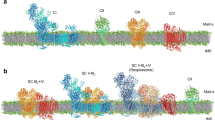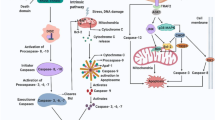Abstract
Bistability in apoptosis, or programmed cell death, is crucial for the healthy functioning of multicellular organisms. The aim in this study is to show the presence of bistability in a mitochondria-dependent apoptosis model under nitric oxide effects using chemical reaction network theory. The model equations are a set of coupled ordinary differential equations arising from the assumed mass action kinetics. Whether these equations have a capacity for bistability (cell survival and apoptosis) is determined using a modular approach in which the model is decomposed into modules. Each module contains only a subset of the whole model and is analyzed separately. It is seen that bistability in a module is preserved throughout the whole model after adding the remaining reactions in the pathway on these modules. It is also found that inhibitor effect of some proteins and the appearance of a reacting protein in a later stage as a product is a desired feature but not sufficient for bistability (in the absence of cooperativity effects). On the whole model, two apoptotic and two cell survival states are obtained depending on the initial cell conditions. The results suggest that the antiapoptotic effects of nitric oxide species are responsible for the bistable character of the apoptotic pathway when cooperativity is not assumed in the apoptosome formation.
Similar content being viewed by others
References
Alberts, B., Johnson, A., Lewis, J., Raff, M., Roberts, K., & Walter, P. (2002). Molecular biology of the cell (4th ed., pp. 1010–1026). Garland Science.
Bagci, E. Z., Vodovotz, Y., Billiar, T., Ermentrout, B., & Bahar, I. (2006). Bistability in apoptosis: roles of bax, Bcl-2, and mitochondrial permeability transition pores. Biophys. J., 90, 1546–1559.
Bagci, E. Z., Vodovotz, Y., Billiar, T., Ermentrout, B., & Bahar, I. (2008). Computational insights on the competing effects of nitric oxide in regulating apoptosis. PLoS J., 3, e2249.
Banaji, M., & Craciun, G. (2009). Graph-theoretic approaches to injectivity and multiple equilibria in systems of interacting elements. Commun. Math. Sci., 7(4), 867–900.
Beere, H. M., Wolf, B. B., Cain, K., Mosser, D. D., Mahboubi, A., Kuwana, T., Tailor, P., Morimoto, R. I., Cohen, G. M., & Green, D. R. (2000). Heat-shock protein 70 inhibits apoptosis by preventing recruitment of Procaspase-9 to the Apaf-1 apoptosome. Nat. Cell Biol., 2, 469–475.
Bentele, M., Lavrik, I., Ulrich, M., Stosser, S., Heermann, D. W., Kalthoff, H., Krammer, P. H., & Eils, R. (2004). Mathematical modeling reveals threshold mechanism in CD95-induced apoptosis. J. Cell Biol., 166, 839–851.
Craciun, G., & Feinberg, M. (2005). Multiple equilibria in complex chemical reaction networks: I. The injectivity property. SIAM J. Appl. Math., 65(5), 1526–1546.
Craciun, G., Tang, Y., & Feinberg, M. (2006). Understanding bistability in complex enzyme-driven reaction networks. Proc. Natl. Acad. Sci. USA, 103(23), 8697–8702.
Curtin, J. F., & Cotter, T. G. (2003). Live and let die: regulatory mechanisms in FAS-mediated apoptosis. Cell. Signal., 15, 983–992.
Eissing, T., Conzelmann, H., Gilles, E. D., Allgöwer, F., Bullinger, E., & Scheurich, P. (2004). Bistability analyses of a caspase-activation model for receptor-induced apoptosis. J. Biol. Chem., 279, 36892–36897.
Ermentrout, B. (2002). Simulating, analyzing, and animating dynamical systems: a guide to XPPAUT for researchers and students. Philadelphia: SIAM.
Feinberg, M. (1977). Mathematical aspects of mass-action kinetics. In N. Amundson & L. Lapidus (Eds.), Chemical reaction theory: a review. Englewood Cliffs: Prentice-Hall.
Fussenegger, M., Bailey, J. E., & Varner, J. (2000). A mathematical model of caspase function in apoptosis. Nat. Biotechnol. 18, 768–774.
Himmelblau, D. (1973). Morphology of decomposition. In D. Himmelblau (Ed.), Decomposition of large-scale problems. Amsterdam: North-Holland.
Hu, T. M., Hayton, W. L., & Mallery, S. R. (2006). Kinetic modeling of nitric-oxide associated reaction network. Pharm. Res., 23, 1702–1711.
Lavrik, I. N., Golks, A., Riess, D., Bentele, M., Eils, R., & Krammer, P. H. (2007). Analysis of CD95 threshold signaling: triggering of CD95 (FAS/APO-1) at low concentrations primarily results in survival signaling. J. Biol. Chem., 282, 13664–13671.
Legewie, S., Blüthgen, N., & Herzel, H. (2006). Mathematical modeling identifies inhibitors of apoptosis as mediators of positive feedback and bistability. PLoS Comput. Biol., 2, e120.
Loughran, P. A., Bagci, E. Z., Zamora, R., Vodovotz, Y., & Billiar, T. R. (2009). In L. Ignarro (Ed.), The role of nitric oxide in apoptosis and autophagy: biochemical and computational studies, nitric oxide.
Nakabayashi, J., & Sasaki, A. (2006). A mathematical model for apoptosome assembly: the optimal cytochrome C/Apaf-1 ratio. J. Theor. Biol., 242, 280–287.
Özören, N., & El-Deiry, W. S. (2002). Defining characteristics of types I and II apoptotic cells in response to TRAIL. Neoplasia, 4, 551–557.
Potter, S. (2009). Mitochondria… more than meets the eye. LSJM, 1, 16–17.
Ryu, S., Lin, S., Ugel, N., Antoniotti, M., & Mishra, B. (2009). Mathematical modeling of the formation of apoptosome in intrinsic pathway of apoptosis. Syst. Synth. Biol., 2, 49–66.
Saez-Rodriguez, J., Hammerle-Fickinger, A., Dalal, O., Klamt, S., Gilles, E. D., & Conradi, C. (2008). Multistability of signal transduction motifs. IET Syst. Biol., 2, 80–93.
Siehs, C., Oberbauer, R., Mayer, G., Lukas, A., & Mayer, B. (2002). Discrete simulation of regulatory homo- and heterodimerization in the apoptosis effector phase. Bioinformatics, 18, 67–76.
Stucki, J. W., & Simon, H. U. (2005). Mathematical modeling of caspase-3 activation and degradation. J. Theor. Biol., 234, 123–131.
Xiong, W., & Ferrell, J. E. Jr. (2003). A positive-feedback-based bistable ‘memory module’ that governs a cell fate decision. Nature, 426(6965), 460–465.
Zou, H., Li, Y., Lui, X., & Wang, X. (1999). An Apaf-1. Cytochrome C multimeric complex is a functional apoptosome that activates Caspase-9. J. Biol. Chem., 274(17), 11549–11556.
Author information
Authors and Affiliations
Corresponding author
Electronic Supplementary Material
Below is the link to the electronic supplementary material.
Rights and permissions
About this article
Cite this article
Sen, S.M., Bagci, E.Z. & Camurdan, M.C. Bistability Analysis of an Apoptosis Model in the Presence of Nitric Oxide. Bull Math Biol 73, 1952–1968 (2011). https://doi.org/10.1007/s11538-010-9613-5
Received:
Accepted:
Published:
Issue Date:
DOI: https://doi.org/10.1007/s11538-010-9613-5




